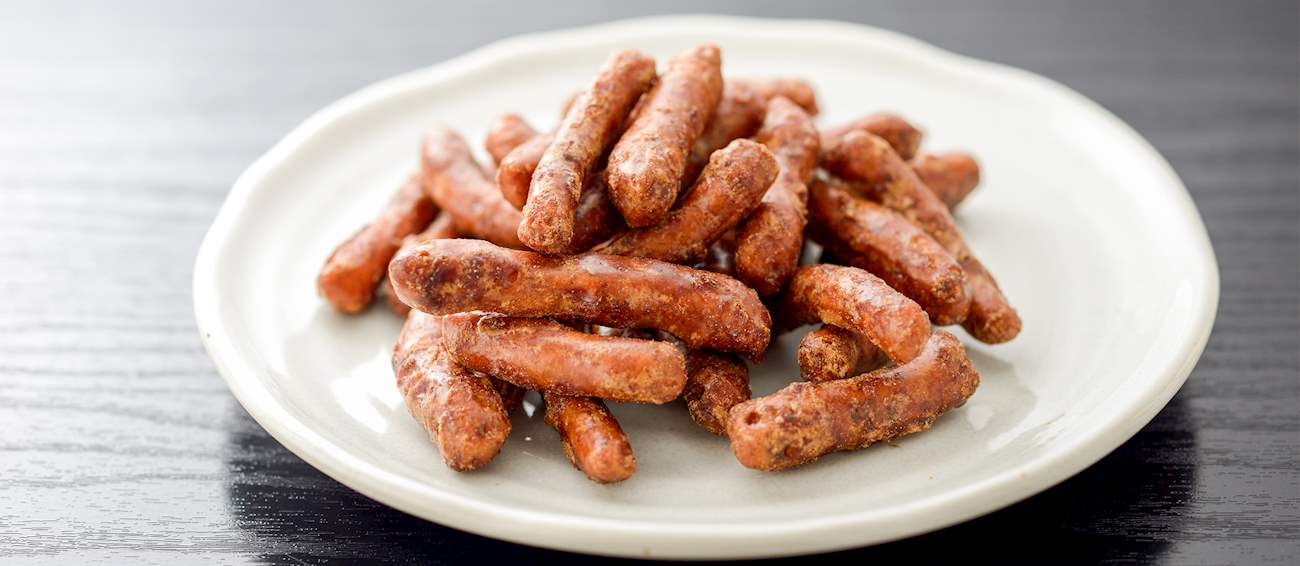Satsuma-age are Japanese fried fish cakes. They can be prepared with various types of fish such as cod, pollock, sardines, mackerel, or tuna, as well as other seafood additions like squid, octopus, or shrimps. Although it is believed they originated and were later named after Satsuma, they are enjoyed throughout the country.
They come in many different forms and may include various vegetables, herbs, and seasonings. Satsuma-age are best enjoyed freshly prepared, and although they can work well on their own, they are also often used as a topping in oden or noodle dishes.
Karintō is a traditional deep-fried snack made from a yeasted dough that is shaped into sticks and then covered in brown sugar. Modern variations often use various flavorings and coat the sticks in peanuts, sesame seeds, or white sugar. The origin of karintō is not entirely clear, but it was most likely available on Japanese streets since the 1830s.
Manjū is a steamed Japanese confectionery product shaped into various forms and incorporating different ingredients and flavors. Usually, there are two main parts of manju, the outer shell, created out of kneaded wheat or rice flour, and the creamy paste hidden inside the chewy outer layer.
The most common variety is produced with wheat flour and filled with red bean paste, popularly called anko or tsubuan. The origins of manjū probably lie in China but are nowadays traditionally associated with Japan. The origin story of this traditional treat says that the original Chinese creation called mantou had a meat filling, but was later altered by the Japanese vegetarian monks and stuffed with a semi-sweet red bean paste.
VARIATIONS OF Manjū
As the name states, yakisoba pan is an unusual Japanese combination of stir-fried yakisoba noodles and plain bread rolls. The noodles are first blended with various vegetables and doused in a thick sauce, and the combination is then stuffed inside the roll.
The concoction is finished with mayonnaise, pickled ginger, and strips of dry seaweed. Yakisoba pan is available in many grocery stores and supermarkets throughout Japan and is usually enjoyed as a nutritious snack or a quick breakfast.
MAIN INGREDIENTS
Mame daifuku is a beloved Japanese sweet dating back to the Edo period. The sweet consists of a rice cake filled with anko, soybeans, or azuki beans. Mame daifuku is commonly served at Japanese tea ceremonies, although it can also be served alongside coffee.
Many believe that it is a morning snack and should be consumed on the same day that it was produced.
MOST ICONIC Mame daifuku
View moreNerikiri is a Japanese wagashi that should reflect the season it's being served in. The most popular shape is that of a cherry blossom, called sakura nerikiri, and it can be bought only in spring. Other shapes might include scenery, flowers, and birds.
This wagashi is traditionally made with sweetened white bean paste and glutinous rice flour. Nerikiri is often served at tea ceremonies, but it also makes for a great sweet snack that can be consumed any time of the day.
Chikuwa is a Japanese product made with salt, sugar, egg whites, starch, and seasoned, ground meat of fishes such as shark, pollock, or flying fish. The ground meat paste is placed around a bamboo stick, and it is then grilled or steamed. The stick gets removed later, leaving a hollow interior.
Chikuwa is regularly consumed on its own as a snack, when it is customary to dip it in soy sauce. It can also be sliced and used as an ingredient in stews and Japanese curries. The name of the product means bamboo stick, referring to the key component in its production.
By far one of the most popular wagashi (traditional Japanese confections) types, dorayaki is a delicious snack consisting of a sweet filling sandwiched between two fluffy pancakes. Its name stems from dora, the Japanese word for a gong, which the dorayaki shape is reminiscent of, and although its origins are in fact said to be ancient, the popular treat took its current form in the early 1900s when it was reportedly first made as a sandwich by a Tokyo-based confectionery called Usagiya.
Ever since, the term dorayaki has been denoting two small pancake-like patties glued together with the so-called anko or sweet azuki red bean paste. The pancake batter is typically flavored with honey, a splash of sweet rice wine called mirin, and even a touch of soy sauce.
MOST ICONIC Dorayaki
View moreMAIN INGREDIENTS
Senbei are crispy rice crackers from Japan, coming in a wide variety of colors, shapes, and flavors. It is believed that the crackers originated during the Tang Dynasty in 737 AD, when they were made with potatoes, glutinous rice, or wheat flour.
Soy sauce-flavored senbei was the first one to be popularized, but later, other varieties of senbei were invented. Traditional types of senbei include sweet senbei and rice candy senbei (savory). Rice-based senbei can be either baked or fried.
VARIATIONS OF Senbei
TasteAtlas food rankings are based on the ratings of the TasteAtlas audience, with a series of mechanisms that recognize real users and that ignore bot, nationalist or local patriotic ratings, and give additional value to the ratings of users that the system recognizes as knowledgeable. For the “9 Worst Rated Japanese Snacks” list until April 19, 2025, 2,329 ratings were recorded, of which 2,023 were recognized by the system as legitimate. TasteAtlas Rankings should not be seen as the final global conclusion about food. Their purpose is to promote excellent local foods, instill pride in traditional dishes, and arouse curiosity about dishes you haven’t tried.



